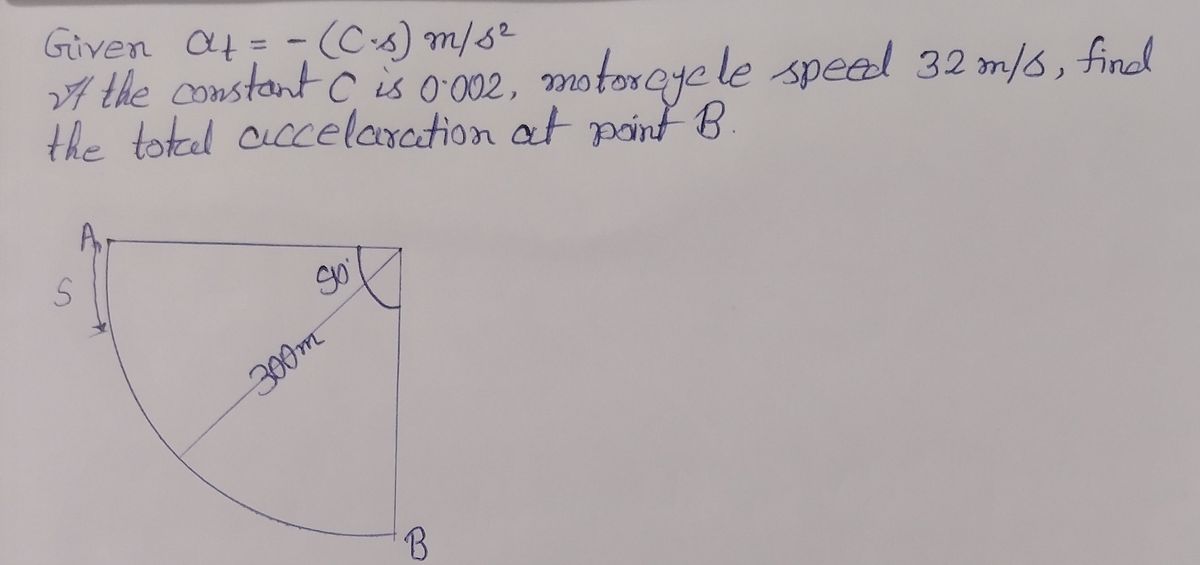Q22. As shown in the image below, a motorcycle travels along circular path from point A to point B. Its decreases at at (C.s) m/s², where Cis a constant and s is the distance (in m) traveled along the path measured from point A. If the constant Cis 0.002, and the motorcycle has speed of 32 m/s at point A, determine the magnitude of its total acceleration (in m/s²) at point B. Please pay attention: the numbers may change since they are randomized. Your answer must include 2 places after the decimal point. .A Your Answer: Answer 90° 300 m n B
Q22. As shown in the image below, a motorcycle travels along circular path from point A to point B. Its decreases at at (C.s) m/s², where Cis a constant and s is the distance (in m) traveled along the path measured from point A. If the constant Cis 0.002, and the motorcycle has speed of 32 m/s at point A, determine the magnitude of its total acceleration (in m/s²) at point B. Please pay attention: the numbers may change since they are randomized. Your answer must include 2 places after the decimal point. .A Your Answer: Answer 90° 300 m n B
Elements Of Electromagnetics
7th Edition
ISBN:9780190698614
Author:Sadiku, Matthew N. O.
Publisher:Sadiku, Matthew N. O.
ChapterMA: Math Assessment
Section: Chapter Questions
Problem 1.1MA
Related questions
Question
![**Q22.** As shown in the image below, a motorcycle travels along a circular path from point A to point B. Its acceleration decreases at \( a_t = - (C \cdot s) \, \text{m/s}^2 \), where \( C \) is a constant and \( s \) is the distance (in meters) traveled along the path measured from point A. If the constant \( C \) is 0.002, and the motorcycle has a speed of 32 m/s at point A, determine the magnitude of its total acceleration (in m/s\(^2\)) at point B. Please pay attention: the numbers may change since they are randomized. Your answer must include 2 places after the decimal point.
### Diagram Analysis:
- The diagram shows a curved path labeled from point A to point B.
- The road appears as a quarter of a circle from A to B.
- Point A and point B are marked, with point B located 300 meters along the arc from point A.
- A right angle (90 degrees) is depicted at the center with reference to the path, implying point B is directly beneath point A in terms of radius alignment.
- The path also displays vectors for normal (\( n \)) and tangential (\( t \)) components.
### Answer Section:
Your Answer:
[Answer Box]
---
**Note**: Students should calculate using the given variables and notice that inputs might vary.](/v2/_next/image?url=https%3A%2F%2Fcontent.bartleby.com%2Fqna-images%2Fquestion%2Fe7171e53-5d05-46c4-abbf-3d7ddeb936a7%2Fef7499b4-34a6-415a-aa72-cd75f3affc71%2F2folxil_processed.jpeg&w=3840&q=75)
Transcribed Image Text:**Q22.** As shown in the image below, a motorcycle travels along a circular path from point A to point B. Its acceleration decreases at \( a_t = - (C \cdot s) \, \text{m/s}^2 \), where \( C \) is a constant and \( s \) is the distance (in meters) traveled along the path measured from point A. If the constant \( C \) is 0.002, and the motorcycle has a speed of 32 m/s at point A, determine the magnitude of its total acceleration (in m/s\(^2\)) at point B. Please pay attention: the numbers may change since they are randomized. Your answer must include 2 places after the decimal point.
### Diagram Analysis:
- The diagram shows a curved path labeled from point A to point B.
- The road appears as a quarter of a circle from A to B.
- Point A and point B are marked, with point B located 300 meters along the arc from point A.
- A right angle (90 degrees) is depicted at the center with reference to the path, implying point B is directly beneath point A in terms of radius alignment.
- The path also displays vectors for normal (\( n \)) and tangential (\( t \)) components.
### Answer Section:
Your Answer:
[Answer Box]
---
**Note**: Students should calculate using the given variables and notice that inputs might vary.
Expert Solution
Step 1

Step by step
Solved in 2 steps with 2 images

Knowledge Booster
Learn more about
Need a deep-dive on the concept behind this application? Look no further. Learn more about this topic, mechanical-engineering and related others by exploring similar questions and additional content below.Recommended textbooks for you

Elements Of Electromagnetics
Mechanical Engineering
ISBN:
9780190698614
Author:
Sadiku, Matthew N. O.
Publisher:
Oxford University Press

Mechanics of Materials (10th Edition)
Mechanical Engineering
ISBN:
9780134319650
Author:
Russell C. Hibbeler
Publisher:
PEARSON

Thermodynamics: An Engineering Approach
Mechanical Engineering
ISBN:
9781259822674
Author:
Yunus A. Cengel Dr., Michael A. Boles
Publisher:
McGraw-Hill Education

Elements Of Electromagnetics
Mechanical Engineering
ISBN:
9780190698614
Author:
Sadiku, Matthew N. O.
Publisher:
Oxford University Press

Mechanics of Materials (10th Edition)
Mechanical Engineering
ISBN:
9780134319650
Author:
Russell C. Hibbeler
Publisher:
PEARSON

Thermodynamics: An Engineering Approach
Mechanical Engineering
ISBN:
9781259822674
Author:
Yunus A. Cengel Dr., Michael A. Boles
Publisher:
McGraw-Hill Education

Control Systems Engineering
Mechanical Engineering
ISBN:
9781118170519
Author:
Norman S. Nise
Publisher:
WILEY

Mechanics of Materials (MindTap Course List)
Mechanical Engineering
ISBN:
9781337093347
Author:
Barry J. Goodno, James M. Gere
Publisher:
Cengage Learning

Engineering Mechanics: Statics
Mechanical Engineering
ISBN:
9781118807330
Author:
James L. Meriam, L. G. Kraige, J. N. Bolton
Publisher:
WILEY